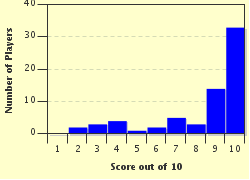Quiz Answer Key and Fun Facts
1. In 1947 Dame Joan Sutherland made her concert debut as the First Queen of Carthage in which opera by the English baroque composer, Henry Purcell?
2. Dame Joan Sutherland made her professional debut as The First Lady in "The Magic Flute", which was written by which great composer?
3. The next step in Dame Joan Sutherland's career was to secure the role of Clotilde alongside the great Maria Callas, who was performing the lead role in which Bellini opera (whose title almost sounds like the name of a Sally Field movie)?
4. Dame Joan Sutherland's first appearance at the Royal Opera House (1952) was in the role of Amelia in which Verdi opera whose title translates as "a masked ball"?
5. Richard Bonynge, Dame Joan Sutherland's husband, suggested that his wife explore the bel canto repertoire and his judgement was soon vindicated by Joan's 1957 performance in which Donizetti opera whose name sounds more Mersey than the composer's native Italy?
6. The opera that provided Dame Joan Sutherland with her biggest break was "Lucia di Lammermoor" which was written by which composer (who should not be mistaken for a ninja turtle)?
7. Dame Joan Sutherland won a Grammy for her 1960 album "The Art of The Prima Donna".
8. The world of opera was so taken by Dame Joan Sutherland's debut at La Fenice in Venice, Italy they nicknamed her "La Stupenda". The opera was "Alcina', who was the German-British composer who wrote it?
9. Striving for perfection in her art, in 1974 Dame Joan Sutherland took on the role of "Esclarmonde", one of the most difficult for a soprano. Which French composer created this masterpiece?
10. Dame Joan Sutherland gave her last full-length performance at the Sydney Opera House in 1983, performing the role of Marguerite de Valois in Giacomo Meyerbeer's "Les Huguenots". Which number, popular with troops during the American Civil War, did she deliver as her encore?
Source: Author
pollucci19
This quiz was reviewed by FunTrivia editor
Pagiedamon before going online.
Any errors found in FunTrivia content are routinely corrected through our feedback system.

